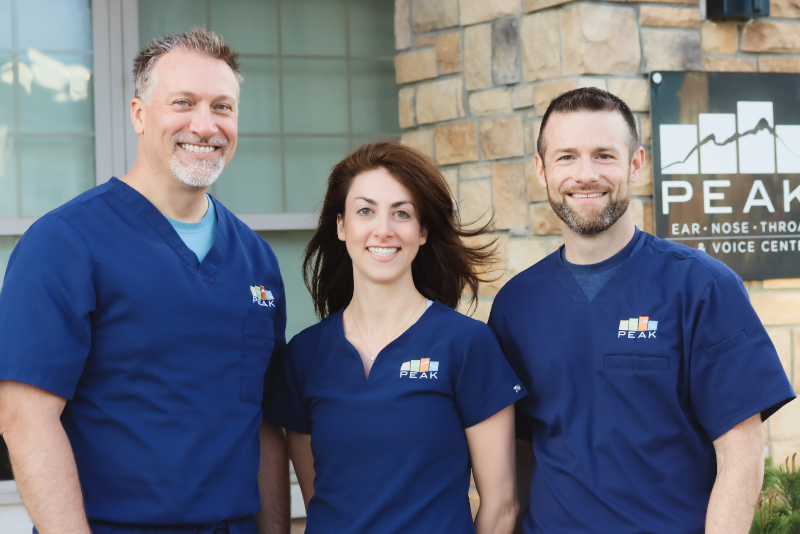Sublingual Immunotherapy
Home » Sublingual Immunotherapy
Sublingual Immunotherapy | Broomfield • Golden • Brighton • Colorado • Denver ENT Doctor
Allergy Team
Allergy Immunologic Treatments. Peak ENT offers fellowship-trained and board-certified otolaryngologists
SUBLINGUAL IMMUNOTHERAPY DROPS (SLIT)
- A very safe treatment that uses the patient’s own immune system to achieve results. The immune system is introduced to the allergen in small and increasing doses until natural immunity is developed.
- Currently considered off-label by the FDA, but uses the same safe and FDA-approved extracts used in traditional subcutaneous immunotherapy (allergy shots).
- Allergy symptoms may potentially begin to subside as early as 1-3 months following the beginning of treatment. Most patients notice an improvement within 6-12 months. Full treatment ranges between 3-4 years and can last many years, if not a lifetime.
- Drops are placed under the tongue and can be taken at home.
- Drops are administered on a daily basis.
- Is a travel friendly treatment option.
- Side effects (if any) are mild and include irritation under the tongue or a temporary increase in allergy symptoms.
The allergy specialists at Peak ENT are committed to providing collaborative, comprehensive care on an individual basis. Working in conjunction with the patient, our team of health care specialists provide in depth, modern health care for the well-being of the patient and their families.
It’s all about the nose!
The Nose is an amazing part of our anatomy that has multiple functions, including:
Smell. This sense is tied to so many aspects of our lives. Smell is hardwired into our emotions and memories. Smell helps us detect potentially harmful situations and avoid these. Even most of what we taste is actually due to our sense of smell.
A filter. Starting with the little hairs in our nostrils, and continuing with the layer of mucus coating the nasal cavity, our nose helps filter and trap particles we breathe, thereby keeping these potentially harmful materials out of our lungs!
A heater. As air flows through the nose, it is warmed closer to body temperature. Warm air is gentler on the lungs than cold air.
A humidifier. The nose can take outside air and increase its relative humidity to 95% or higher by the time it reaches the throat. Moist air is much gentler on the lungs than dry air.
The Sinuses are hollow, air-filled spaces inside the skull and facial skeleton which are lined with mucosa: a thin layer of tissue that secretes mucus. The sinuses drain through small openings into the nose. No one knows for sure why we even have sinuses, but there are several theories, including:
They make our heads lighter and less “front-heavy.” Our necks appreciate this!
They provide resonance for our voice.
They offer a sort of “crumple zone” against trauma, thus preserving our brain at the expense of our face!
While working in harmony with our body most of the time, the nose and sinuses are on the “front line” in terms of exposure to potentially harmful substances in the environment, and are prone to many disorders as a result. Additionally, as a consequence of its central and very prominent position on our face, the nose is particularly susceptible to injury.
Common Nose & Sinus Disorders We Treat:
Chronic Rhinitis: persistent inflammation and swelling of the nasal lining causing symptoms of congestion, runny nose, thickened mucus, and postnasal drip. In severe cases, this can also impact the sense of smell. A variety of causes may contribute to this condition, including allergies, nasal dryness, reactions to chemicals or other irritants, and even hormone changes.
Allergic Rhinitis: inflammation of the nasal lining caused by an allergic reaction typically to small particles called allergens that are inhaled into the nose. Symptoms include runny nose, sneezing, nasal congestion, postnasal drip, itchy nose, itchy and watery eyes, headaches, and scratchy throat. Symptoms may be seasonal or year-round. Allergies can develop at any point during one’s lifetime. Peak ENT offers testing for inhaled and food allergies. Testing can help determine if you are a good candidate for immunotherapy, a method of desensitizing your body and reducing its allergic response to these substances.
Nasal Polyps: gelatinous “bags” of swollen nasal lining can occur in susceptible patients as a result of chronic inflammation in the nose and may be associated with allergies, chronic sinus blockage/infection, asthma, and in some patients a sensitivity to aspirin and/or non steroidal anti-inflammatory medications (NSAIDs). Polyps cause significant nasal congestion, blocked nasal breathing, stuffy nose and loss of smell. Extensive nasal polyps often require a combined approach including sinus surgery as well as medical management.
Deviated Septum: a condition in which the nasal septum, or wall that divides the inside of the nose in half, is bent, causing blockage of one or both nasal passages. The main symptom patients experience is difficulty breathing through the nose. A deviated septum may also contribute to other symptoms, including sinus infections, nosebleeds, nasal dryness, snoring and headaches. In some cases, medical treatment using nasal moisturizers as well as a nasal steroid spray can provide adequate symptom relief. In other cases, a surgical procedure called septoplasty may be beneficial.
Turbinate Hypertrophy: The nasal turbinates are folds of tissue inside the nose attached to the outer wall of the nasal cavity. They help warm and moisturize the air we breathe. The turbinates also readily swell in response to inflammation, and are the reason we feel congested when we have allergies, a cold, or a sinus infection. In some patients, the turbinates become chronically swollen, contributing to symptoms of nasal obstruction. Attempts are made to identify and treat any underlying causes of inflammation. If symptoms persist, a procedure called turbinate reduction may be helpful. This procedure is routinely performed with a septoplasty when a deviated septum is present, but may also be performed as a stand-alone procedure. In adults, a turbinate reduction can be performed quickly and with minimal discomfort under local anesthesia in the office.

Chronic or Recurrent Sinusitis: Symptoms of sinusitis may include nasal congestion, thick drainage from the nose or into the throat, pressure in the face, headaches, fatigue, bad breath, cough, and loss of smell. Chronic sinusitis refers to sinus inflammation that causes symptoms lasting more than 3 months. Recurrent sinusitis refers to symptoms that occur on an intermittent but frequent basis. Symptoms typically last 10 or more days, then completely resolve in between episodes. Causes of sinusitis may include infection, allergic or nonallergic inflammation, irritant exposure, or narrowed/blocked sinus passages. Often there is more than one cause present in any given patient. A thorough examination by one of the physicians at Peak ENT can help determine the underlying cause(s) of your sinusitis, thus allowing an individualized treatment plan. Recommended treatments may include antibiotics, anti-inflammatory medications, or surgery to open blocked sinus passages. In appropriate candidates, a simple in-office procedure can provide substantial relief.

Snoring, we understand!
Snoring can also be a sign of a more serious problem, known as obstructive sleep apnea. Sleep apnea occurs when the tongue and muscle in the back of the throat completely obstruct the airway and breathing is momentarily halted. Patients with sleep apnea typically stop breathing many times a night before the brain prompts them to wake up and start breathing again. Most patients don’t fully awaken or realize this is occurring all night long, but they wake up feeling unrested and tired through out the day. Daytime fatigue causes decreased alertness and productivity, not to mention the dangers of falling asleep while driving or performing other important tasks. Left untreated, long-term complications of sleep apnea include high blood pressure, heart attacks, stroke, heart failure, anxiety and depression.
Sleep apnea is diagnosed through a physical examination with particular emphasis on weight, blood pressure and airway constriction in the nose, throat and lungs. In many cases, a sleep test will be recommended at a sleep laboratory. The sleep study monitors several functions while you sleep and can help identify the exact cause and severity of the sleep apnea.
Conservative measures for alleviating mild apnea include sleeping on your side (not on your back) and avoiding alcohol or sedatives before bedtime. In mild cases, treatment may consist of nasal decongestants, inhaled steroid preparations or oral mouth devices that force the jaw forward and prevent the tongue from falling back and obstructing the throat. For more severe cases, your doctor may prescribe Continuous Positive Airway Pressure (CPAP). This device straps onto your face and generates pressurized air, keeping the airway open during sleep. CPAP can often cure sleep apnea. Sometimes surgery can decrease the severity of sleep apnea, but rarely results in a cure. The most common procedures to treat sleep apnea or snoring include a tonsillectomy, adenoidectomy, deviated septum repair (septoplasty), or surgery on the palate and uvula.
Septoplasty is different from Rhinoplasty where in addition to helping nasal breathing, the nose can be reshaped to create a change or improvement in appearance. All of the physicians at Peak ENT have extensive experience performing this procedure.

Postnasal Drip


Severe nosebleeds are often managed in the Emergency Room by placing a pack in the nose. This will stop most nosebleeds. The pack is then removed typically 2-5 days later in our office. If a source of the bleeding can be identified after removing the pack, your ENT doctor may cauterize this area to help prevent another bad nosebleed.
For recurring, more minor nosebleeds, your ENT doctor will first thoroughly examine your nose to identify the likely source of the problem. Recommended treatments may include a regimen of moisturizers for the nose, avoidance of trauma to the nose such as with nose-picking, or cauterization of the offending blood vessel. Nasal cauterization is a simple procedure that can usually be performed in the office under topical anesthesia, with minimal discomfort.

They make our heads lighter and less “front-heavy.” Our necks appreciate this!
They provide resonance for our voice.
They offer a sort of “crumple zone” against trauma, thus preserving our brain at the expense of our face!
Symptoms of sinusitis may include nasal congestion, thick drainage from the nose or into the throat, pressure in the face, headaches, fatigue, bad breath, cough, and loss of smell. Chronic sinusitis refers to sinus inflammation that causes symptoms lasting more than 3 months. Recurrent sinusitis refers to symptoms that occur on an intermittent but frequent basis. Symptoms typically last 10 or more days, then completely resolve in between episodes. Causes of sinusitis may include infection, allergic or nonallergic inflammation, irritant exposure, or narrowed/blocked sinus passages. Often there is more than one cause present in any given patient.
A thorough examination by one of the physicians at Peak ENT can help determine the underlying cause(s) of your sinusitis, thus allowing an individualized treatment plan.
Recommended treatments may include antibiotics, anti-inflammatory medications, or surgery to open blocked sinus passages. Usually surgery is recommended only after other treatments have failed. In appropriate candidates, a simple in-office procedure can provide substantial relief.

Our Specialists Team



